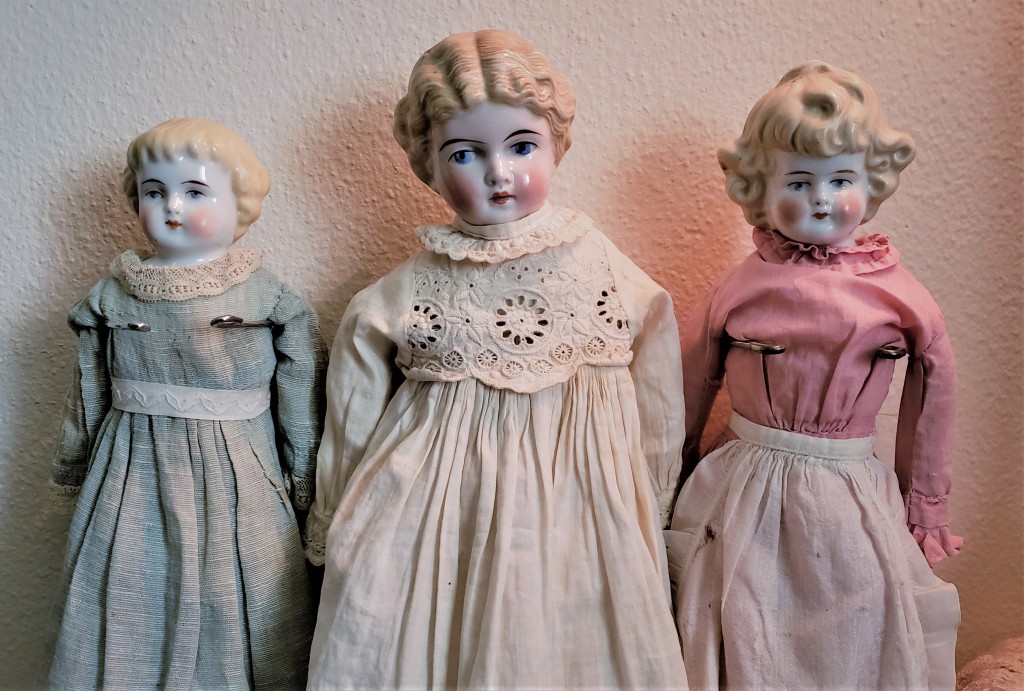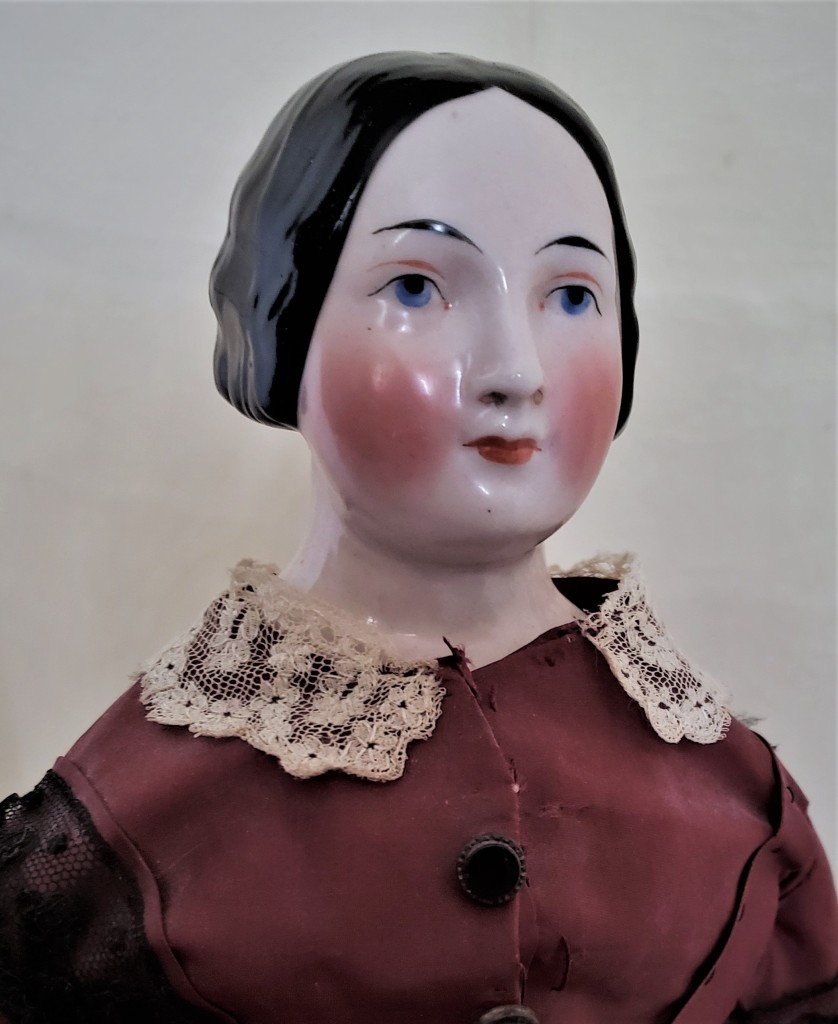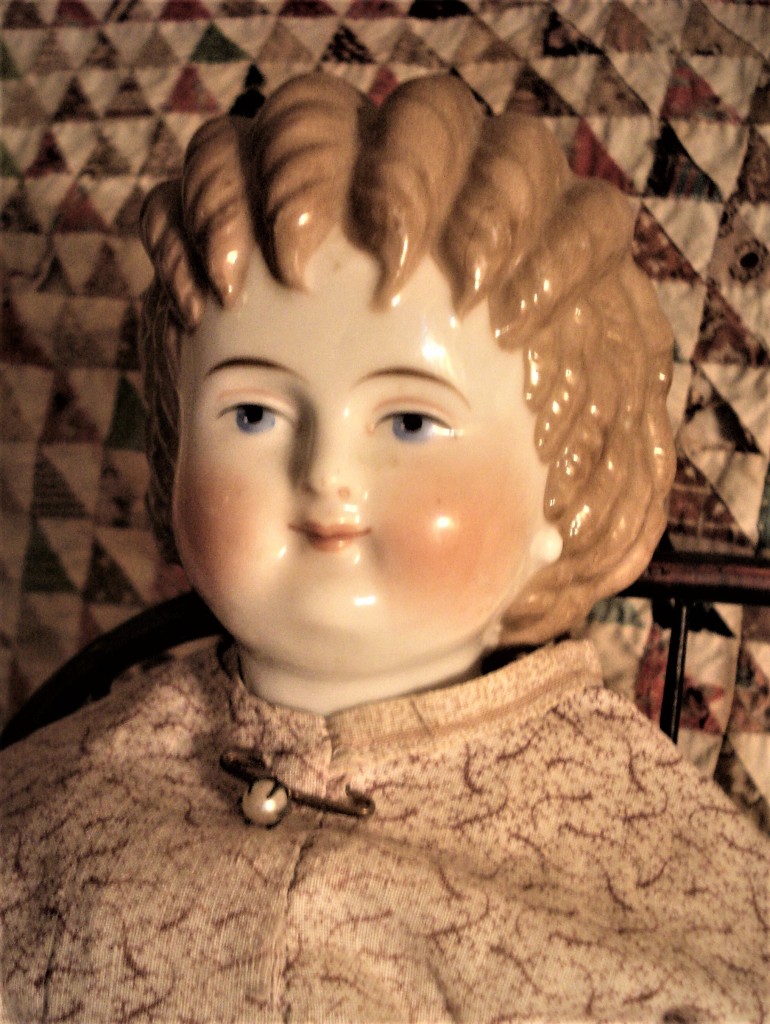
Promised long ago, here, finally, is a brief description of the seven prominent porcelain factories that produced china doll shoulder-heads, china doll parts, and the Frozen Charlottes or full body porcelain bathing dolls. All dolls shown are from the author’s collection.
Many of the china dolls that we collect today were manufactured in Germany, though there were porcelain factories in other countries that made china dolls as well. There were seven prominent factories in Thuringia, Germany making china dolls from the early 1840’s through the 1930’s. These factories are J. D. Kestner, A.W. Fr Kister, Kloster Veilsdorf, Conta & Boehme, C.F. Kling & Co., Alt, Beck & Gottschalk (ABG), and Hertwig & Co. Most of these factories did not mark their dolls, especially in the early years of production.


There were other smaller and less well known factories throughout Europe producing china dolls as well. Schlaggenwald was a Czech factory to whom the “Grape Lady” doll is attributed. This doll was formerly thought to have been made by KPM; however, it is now known that KPM always marked their dolls. The Swedish company of Rorstrand made high quality china dolls, as did Jacob Petit in France. The first Huret dolls were china heads, and Royal Copenhagen of Denmark made china dolls of superb quality. China dolls were produced in England, as well. It is rare to find dolls from these manufacturers on the market, and pricey when they are available.
The Seven Thuringian Porcelain Factories and Their Dolls
Mary Gorham Krombholz tells us in her introduction to A Pictorial Reference to German Chinas that KPM Meissen and KPM Berlin made the first glazed porcelain shoulder heads in the early 1840’s. Shortly after, Conta & Boehme, J.D. Kestner, A.W.Fr Kister, and Kloster Veilsdorf porcelain factories began making glazed porcelain shoulder heads and lower limbs. C.F. Kling, Alt Beck & Gottschalk, and Hertwig and Co. followed soon after with their production of glazed porcelain dolls and doll parts. China dolls were made in Germany for a hundred years. By comparing a group of china dolls with known examples from each of these porcelain factories, it becomes more apparent by the details of the facial painting which dolls were made by which factories.


J. D. Kestner: The Kestner porcelain factory, located in Waltershausen, made dolls and doll related porcelain products from the 1840’s until the factory closed in 1938. China shoulder heads were made by the Kestner firm at least through the 1860’s, and they were noted for their bisque dolls thereafter. This firm made a wide variety of dolls in many hairstyles including tauflings, frozen dolls, and colorful boots for the china cloth bodied dolls. Kestner china dolls can most readily be identified by their mouth painting, which always features a thin unpainted space between the upper and lower lips. The eyebrows are mostly thin, single stroke, with a slight arch. Eyes of earlier dolls have partial black outlines on the irises with a white highlight dot on the left side. Later dolls have darker shading to highlight the iris rather than the black outline, continuing with the highlight dot on the left side. Smaller dolls do not have iris outline or highlight dots.


A.W.Fr Kister: This factory, located in the small town of Scheilbe-Alsbach, was founded in 1834. China shoulder heads were made from the 1840’s at least to the 1870’s. In 1893 the company employed 170 factory workers and 340 in home trade. In 1949, the company still made jointed dolls, doll heads, and tea-cozy dolls. Kister made beautiful bun haired ladies, Lydia and Sophia Smith, Covered Wagon, followed by flat top, rounded flat top, and eventually fancy hair styles. The mouth painting on Kister dolls is the most distinctive. The upper lip has low, far spaced peaks with a long, narrow lower lip which is shorter than the upper lip. Sometimes the lower lip resembles a horizontal oval, not quite meeting the upper lip. Single stroke eyebrows are nearly straight with very little arching. The eyes are nearly always painted the same shade of blue and are not highlighted or outlined.


Kloster Veilsdorf: Founded in 1765 in the town of Veilsdorf, the earliest entry for doll production in the Cieslik’s German Doll Production is noted at 1863, with the last being 1930. However, Kloster Veilsdorf china shoulder-heads date from the early 1850’s. The company made half dolls, frozen Charlottes, and shoulder heads. The “Greiner Type” dolls are made by this company, as well as many chinas with molded hair ornaments of feathers and bows. Mouth painting on these dolls is similar, with upper and lower lip edges meeting with a longer center line. Eyelids are often molded. Eyebrows are also similar on all the dolls, most being single stroke, with some multi stroke, and arched. Irises are much wider than on dolls from the other six German factories, with a dark blue outline (black on brown eyes) and a highlight dot. Some dolls, such as the Greiner types, have painted eyelashes. While Krombholz reports that no other factory painted lashes on their glazed porcelain dolls, I recently found a pink tinted Kestner covered wagon hairstyle china shoulder-head with feathered eyebrows and painted lower lashes.


Conta Boehme: In Poessneck, this factory was in business from 1800 until 1931. Doll production went from the 1850’s until the factory closed. Some dolls are marked with a shield with bent arm inside. Mouth painting is most distinctive with high upper lip peaks, closely spaced, ending with a curl. The sleepy, heavy lidded eyes are the most recognizable feature, and many chinas have molded eyelids. A red line outlines the entire eyelid crease. The pupil is usually not round, but touches the black lid line, as if the eyelid is partially closed. Irises are shaded but seldom outlined. White iris highlights can be on the left or right side of the pupil.


C. F. Kling & Co.: Located in the town of Ohrdruf, Kling made porcelain products from its founding in 1834 until the early 1950’s. Dolls were made from the early 1850’s. After starting with bald head chinas, this factory went on to design shoulder heads with elaborate hairstyles and shoulder plates that are unequaled in modeling and facial painting, most notably with their Parian dolls. Single stroke eyebrows are thin and well arched, curling slightly down on the ends. Almond shaped eye sockets often have glass or painted eyes. (Glass eyes include painted eyelashes.) Painted eyes have large round irises with white highlights on the left side of the pupil. The upper lip is heart shaped, but unlike Hertwig, the lower lip is a half circle rather than an elongated oval. The upturned accent line is the same color as the lips.


Alt Beck & Gottschalk: With two factories, located in Nauendorf and Stutzhaus, this company made chinas and parians from 1864. In 1910 the factory was sold to Hertel, Schwab & Co. ABG made simple and fancy haired chinas, and is well known for the many kinderkopfs (child heads) of the 1880’s. Most recognizable are the painted mouths as this is the only factory that used a darker line between the lips, and it dips to a small “v” in the center. Eyebrows are single stroke, thicker in the middle, tapering to thin lines on the ends. Painted irises are often partially outlined in darker blue or black, and have a tiny raised white highlight dot on the left side of the iris, like a tiny drop of paint.


Hertwig & Co.: Open from 1864 until the 1990’s, Hertwig began making dolls in 1865, and produced china or bisque dolls through 1941. The earliest dolls were most likely made of un-glazed porcelain. While the shoulder heads most readily associated with Hertwig are the lowbrow and Pet Name chinas, they also made flat top, Highland Mary, and bonnet head dolls, as well as the Snow Babies. Mouths have a heart shaped upper lip with a deep oval forming the bottom lip. Irises are not outlined or highlighted. Single stroke eyebrows are painted in a wrap around style. Many Hertwig dolls have a large incised number, or size number and “Germany” on the back of their shoulder plates.

China dolls were beloved by children from before the American Civil War, to as recently as the Great Depression. They are frequently family heirlooms, and are a favorite for discerning collectors of antique dolls of the 19th century. While china dolls were mass produced as early as the 1840’s, and made by companies in Denmark, France, Czechoslovakia, and England, the china dolls that we are most familiar with as collectors were made by seven porcelain manufacturers in Thuringia, Germany, through the 1930’s. Hair styles are molded and constant on almost all of these dolls; therefore can be an indication of when the style was first manufactured. Shoulder shape can also indicate dating for the doll. Different companies manufactured different styles of china limbs for their dolls. However, facial painting is the clearest and best indicator of which porcelain company manufactured which doll. Mary Gorham Krombholz’s research in Germany, visits to the factory sites in the 1990’s (many of which have been demolished since then), and lengthy study of the German chinas has allowed us to now identify these ethereal beauties who long had remained enigmas in the world of antique dolls.
Reference:
Krombholz, Mary Gorham. Identifying German Chinas 1840s – 1930s. Grantsville, MD: Hobby House Press, Inc., 2004.
Mary Krombholz’s first book on china dolls is organized chronologically by decades when the dolls were made. It is an excellent resource for learning the many types of china dolls, and learning how to distinguish by which factory an unmarked doll was made based on face painting characteristics. Only the heads and shoulder-plates are shown for most of the dolls, so bodies, limbs, and costumes are not part of the research line in this book.
Krombholz, Mary Gorham. A Pictorial Reference Guide for German Chinas, 2009.
The newer book by Mary Krombholz is organized by factory, giving a better overview of the history of the seven major Thuringian porcelain factories that manufactured china dolls. This organization is more intuitive for comparing dolls made by one factory. A page of painting characteristics for that factory is included at the end of each chapter, with a range of examples shown. As with the previous book, the focus is on the shoulder-heads, not on the complete doll.

This post is dedicated to Mary Krombholz who’s research into the German porcelain factories that produced many of the china dolls we love, and who’s research into the dolls, comparing known examples from factories, has clarified so much about these dolls and their makers. Thank you, Mary.
